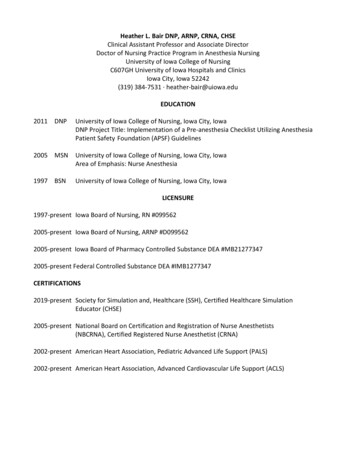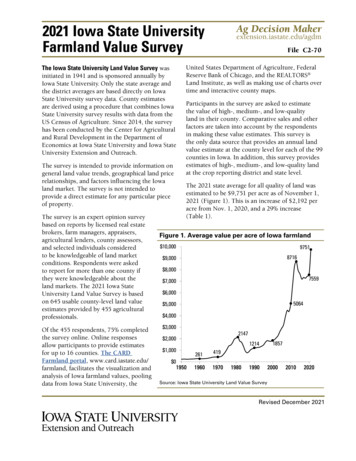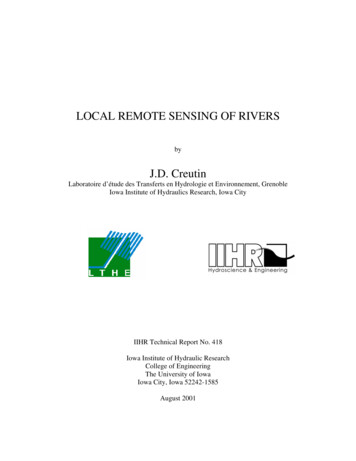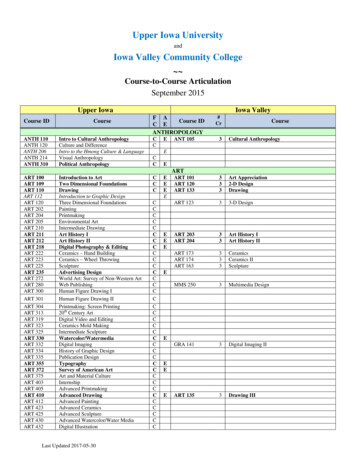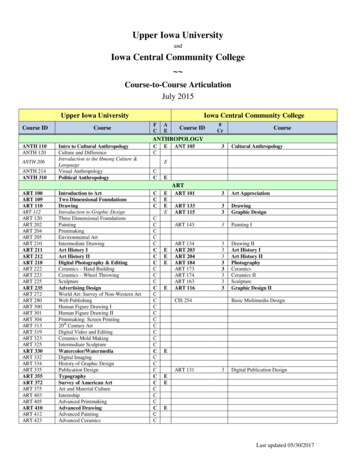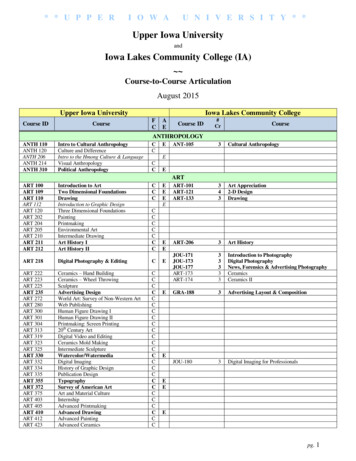
Transcription
Lead Awareness2408 Wanda Daley DriveAmes, Iowa 50011-3602(515) 294-5359 www.ehs.iastate.eduCopyright Reviewed 2020
Lead Awareness2
Lead AwarenessDirectory of Service and Emergency ProvidersServicesEnvironmental Health and Safety2408 Wanda Daley Drive (515) 294-5359Iowa State University Occupational Medicine DepartmentG11 Technical and Administrative Services Facility (TASF), 2408 Pammel Drive (515) 294-2056McFarland Clinic PC, Occupational Medicine1018 Duff Avenue (515) 239-4496Thielen Student Health Center2647 Union Drive (515) 294-5801EmergencyEmergency - Ambulance, Fire, Police911Department of Public Safety/ Iowa State University PoliceArmory, 2519 Osborn Drive (515) 294-4428Mary Greeley Medical Center1111 Duff Avenue (515) 239-20113
Lead AwarenessTable of ContentsDirectory of Service and Emergency Providers 3Lead - What is it? And Where is it? 5What is a lead-based paint? 5What’s the problem? 5Disturbing Lead 5Where is it? 5What are the health effects? 6Lead Detection – How do we know? 7How do we minimize exposure? 7Housekeeping 9Environmental Protection Agency 9Occupational Safety and Health Administration 9Department of Housing and Urban Development 9Iowa Department of Public Health 10Consumer Product Safety Consumer 10Summary Non-discrimination Statement 41011
Lead AwarenessLead - What is it? And Where is it?Lead is a naturally occurring, heavy, bluish metal that has been usedfor centuries in manufactured products. Lead is nearly indestructibleand is non-biodegradable. No known technology will destroy or renderlead harmless.Lead is mined as ore in many countries throughout the world andrefined for use in the following products: paint batteries gasoline glazing pottery glaze solder water and sewer pipingAs of 2008, residential paint can only contain a maximum of .009% lead.What is a lead-based paint?The Department of Housing and Urban Development (HUD) and IowaState University (ISU) defines lead-based paint as any paint or othersurface coatings that contain lead equal to or in excess of 0.5% byweight or 1.0 mg/cm² using an XRF direct reading instrument. Thisincludes varnishes and stains.What’s the problem?Disturbing LeadIf lead is present on or in a surface being disturbed by sanding,scraping, or welding, persons performing the work, as well asoccupants of the surrounding area, may be exposed to lead.Where is it?At ISU, lead-based paint poses the primary risk for leadexposure. Paint preparation (scraping and sanding), renovationand demolition activities can all generate significant personalexposures.5
Lead AwarenessLeaded paint has been used in many of the buildings on campus.It is most commonly found on exterior surfaces, but has alsobeen identified on original plaster walls and industrial coatings onstructural support beams. Lead-based paint was used more oftenin pre-World War II construction but can be found in buildings builtbefore the 1980s.In 1978, the Consumer Product Safety Commission (CPSC)banned the use of lead in residential paint. As a result, mostbuildings built after 1978 are not typically considered to be a riskfor lead contamination from paint.The activities that present the greatest risk for lead exposureinclude: demolition renovation painting projects (interior and exterior) plumbing and soldering firing range activities window glazingWhat are the health effects?Lead is recognized as a serious health hazard for anyone who inhalesor ingests it.Lead-containing paint onwindow systemLearn more with the EPA, ProtectYour Family From Lead In YourHome. brochureSmall lead particles that enter the lungs or digestive tract will beabsorbed into the blood stream where the lead becomes a poison.Disturbed lead particles may also settle on your skin, hair, and clothing.Eating, drinking, or smoking without first washing your hands afterexposure can deliver additional lead into your system. Once insideyour body, lead interferes with the brain, nerves, kidneys and bloodforming systems. When lead levels become high enough, lead can bestored in the bone marrow, where it may be released into the body ata later time. Damage from chronic lead poisoning may be irreversibleand acute exposures can be fatal.In adults, symptoms of lead poisoning include: abdominal pain digestive problems headaches high blood pressure impotence kidney damage6
Lead Awareness memory and concentration problems muscle pain sleep disturbancesDeveloping fetuses and young children under the age of six are mostsusceptible to lead exposure. Lead has no biological value to thebody and will replace calcium in children. Relatively low levels oflead can inhibit growth in developing fetuses. In young children, leadmay cause irreversible damage to the developing nervous system,resulting in behavioral and learning problems. Slowed growth, hearingproblems, and kidney damage are also possible effects.Lead Detection – How do we know?The presence of lead is most commonly identified through these twomethods: Laboratory Analysis - A small sample of paint chips (5 grams)is collected to represent a cross section of paint down to thesubstrate. This method is extremely accurate however, it isdestructive and results often take one to two weeks.X-Ray Fluorescence Device XRF Testing - An x-ray Fluorescence (XRF) device uses aradioactive source to excite lead molecules present in materials.XRF allows for nondestructive testing of materials with substratecorrection.Environmental Health and Safety (EH&S) maintainsan XRF testing device that is used for testing materials that yoususpect may contain lead. Specialized training is required for users.How do we minimize exposure?Maintenance tasks may require the disturbance of lead containingmaterials. In order to minimize exposure to the individual conductingthe work and others in the area, and to avoid contamination ofuniversity property, a number of procedures are recommended.Most of the procedures reflect common sense approaches and canbe accomplished with minimal effort.Contact EH&S at (515) 294-5359 to initiate testing. Lead safe workpractices include: High Efficiency Particulate Air (HEPA) filtered ventilation fortools. Use HEPA filtered vacuum for any cleanup. Use a drop cloth to collect debris. Do not leave lead dust/debris. Work involving lead materials should be conducted when areasare unoccupied. Heat guns operating below 700 degrees Fahrenheit.7
Lead Awareness Use chemical solvents or pastes. Wet sanding, scraping, and sawing. On-site washing facilities and following good hygiene practices. Avoid methods with high exposure potential. Do NOT use: heat guns operating above 700 degrees F unshrouded and non-HEPA filtered tools welders on painted surfaces uncontained hydro-blasting or high pressure wash chemical strippers containing methylene chlorideAdditional information and guidance is available by callingEnvironmental Health and Safety (EH&S) at (515) 294-5359.What personal protective equipment (PPE) andpersonal hygiene methods should we use?Since inhalation is the primary route of exposure to lead dust for adults,the first line of defense is respiratory protection. Avoid breathing anydust that you suspect may contain lead particles. If monitoring indicates that the work you are conducting exceedsthe OSHA Permissible Exposure Limit (PEL), use a half-facerespirator with HEPA (P100) filters. Use gloves to minimize contamination to your hands. Wear disposable protective coveralls. Wash your hands before eating, drinking, or smoking.8
Lead AwarenessHousekeepingUse HEPA filtered vacuums and/or wet wiping when cleaning surfacespainted with lead paint.Wet wiping should be accomplished with wipes soaked with adetergent solution. Never use compressed air to clean up leadcontaminated dust.How do the EPA, OSHA, HUD, IDPH and the CPSCregulate lead?Environmental Protection AgencyThe Environmental Protection Agency (EPA) has adopted rulesthat govern the training required for workers who remove ordisturb surfaces containing lead, inspectors who inspect for lead,and assessors who determine the relative risk posed by thepresence of lead containing materials. The EPA rules dictate howwork involving lead abatement, assessment and inspection mustbe carried out.Residential Lead – EPA rules also require landlords to discloseto prospective tenants any knowledge concerning the presenceof lead paint in the housing being leased. Sellers of housing mustdisclose any knowledge of the presence of lead paint to the buyeror agent and must allow the buyer 10 days to conduct a leadinspection. An EPA pamphlet is available describing the hazardsof lead in the home.Occupational Safety and Health AdministrationThe Occupational Safety and Health Administration (OSHA)established regulations governing construction worker exposureto lead. Employers of construction workers engaged in the repair,renovation, removal, demolition, and salvage of structures andmaterials are responsible for the development and implementationof a worker protection program in accordance with Title 29 Codeof Federal Regulations (CFR), Part 1926.62. This programis essential to minimize worker risk of lead exposure. OSHAregulations in Iowa are enforced by the Iowa Division of Laborthrough the Iowa Occupational Safety and Health (IOSH) bureau.Department of Housing and Urban DevelopmentThe Department of Housing and Urban Development (HUD) hasissued rules that specifically govern abatement, inspection andrisk assessment that cover “Target” (Pre-1978, Federally fundedand Native American) housing. While these rules only cover9
Lead Awareness“Target” housing, they have been referenced by many other stateregulations and related lead-specific guidelines.Iowa Department of Public HealthThe Iowa Department of Public Health (IDPH) has establishedrules covering training and certification requirements for workersand professionals who conduct work associated with lead testing,removal and abatement.Consumer Product Safety ConsumerThe Consumer Product Safety Commission (CPSC) is chargedwith protecting the public from unreasonable risks of injuryor death associated with the use of the thousands of types ofconsumer products under the agency’s jurisdiction. CPSC iscommitted to protecting consumers and families from productsthat pose a fire, electrical, chemical, or mechanical hazard. CPSCworks to ensure the safety of consumer products, such as toys,cribs, power tools, cigarette lighters, and household chemicals.The Commission’s regulations at 16 CFR 1303.1 ban consumerproducts in which the lead content is in excess of 0.009 percent ofthe weight of the total nonvolatile content of the paint.SummaryPlease call EH&S at (515) 2945359 if you have any questionsconcerning lead exposure orthe information in this booklet.10The health effects from lead exposure are serious. Lead-basedpaint is the primary material associated with lead exposure risks forthose working at Iowa State University. In addition to lead paint, leadexposures can result from glazings, solder, electrical and plumbingconnections, and other lead containing materials. Informationpresented in this publication will help minimize potential exposures toyou, your coworkers, and your family.
Lead AwarenessNon-discrimination Statement“Iowa State University does not discriminate on the basis of race, color, age, ethnicity, religion, nationalorigin, pregnancy, sexual orientation, gender identity, genetic information, sex, marital status, disability,or status as a U.S. veteran. Inquiries regarding non-discrimination policies may be directed to Office ofEqual Opportunity, 3350 Beardshear Hall, 515 Morrill Road, Ames, Iowa 50011, Tel. 515 294-7612, emaileooffice@iastate.edu”11
Lead Awareness 2 3 Directory of Service and Emergency Providers Services Environmental Health and Safety 2408 Wanda Daley Drive (515) 294-5359 Iowa State University Occupational Medicine Department G11 Technical and Administrative Services Facility (TASF), 2408 Pammel Drive (515) 294-2056


